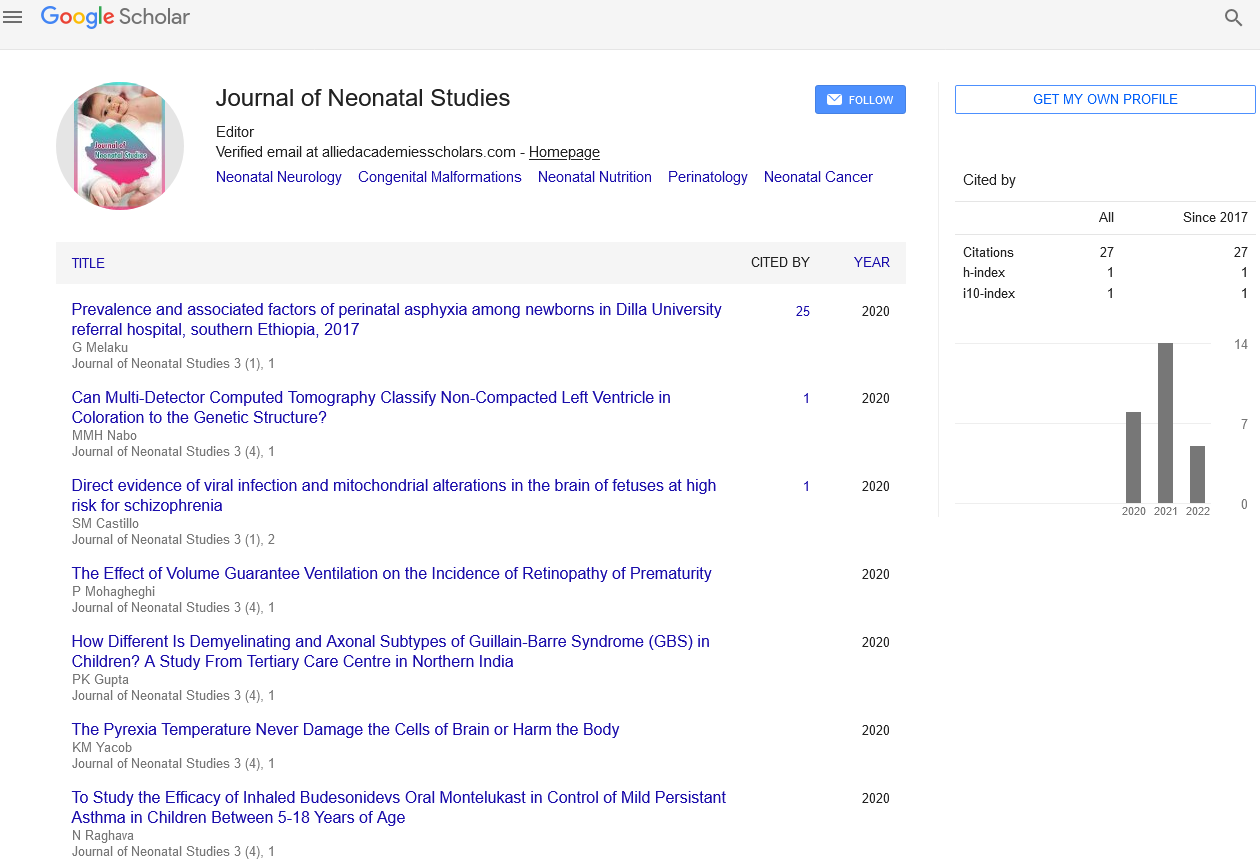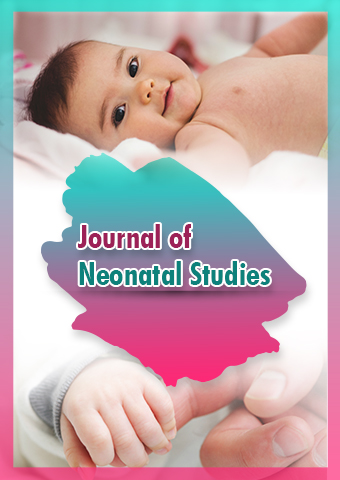Mini Review - Journal of Neonatal Studies (2023) Volume 6, Issue 3
Neonatal Sepsis: Understanding the Silent Threat to Newborns
Pfueller Caspar*
Neuro Cure Clinical Research Center, Charité Universitäts, Medizin Berlin, Berlin, Germany
Neuro Cure Clinical Research Center, Charité Universitäts, Medizin Berlin, Berlin, Germany
E-mail: pfueller.caspar@charite23.de
Received: 1-June-2023, Manuscript No. jns-23-104269; Editor assigned: 2-June-2023, PreQC No. jns-23- 104269(PQ); Reviewed: 15-June- 2023, QC No. jns-23-104269; Revised: 23-June-2023, Manuscript No. jns-23- 104269(R); Published: 30-June-2023, DOI: 10.37532/jns.2023.6(3).82-84
Abstract
Neonatal sepsis is a life-threatening condition characterized by a systemic infection in newborn infants during the first 28 days of life. It is a significant cause of morbidity and mortality, particularly in developing countries. This article aims to provide a comprehensive overview of neonatal sepsis, including its causes, risk factors, clinical presentation, diagnosis, treatment, and preventive measures.
Keywords
Neonatal sepsis • Infection • Infants • Birth
Introduction
Causes and risk factors
Neonatal sepsis can be caused by bacterial, viral, or fungal pathogens. Common bacterial agents include Group B Streptococcus, Escherichia coli, and Staphylococcus aureus. Risk factors for neonatal sepsis include premature birth, low birth weight, prolonged rupture of membranes, maternal infections during pregnancy, lack of prenatal care, invasive procedures, and prolonged hospital stays.
Clinical presentation and diagnosis
The clinical presentation of neonatal sepsis can vary widely, ranging from non-specific signs such as lethargy, poor feeding, and temperature instability to more severe manifestations, including respiratory distress, jaundice, seizures, and shock. Early diagnosis is crucial for prompt treatment. Diagnostic tests include blood cultures, complete blood count, C-Reactive Protein (CRP) levels, and other laboratory investigations to identify the causative pathogen and assess the severity of the infection [1, 2].
Treatment and management
Timely and appropriate treatment is critical in neonatal sepsis. Antibiotic therapy should be initiated promptly, targeting the most likely pathogens based on local guidelines and the infant’s clinical condition. Empirical antibiotic therapy may be started while awaiting culture results, and the choice of antibiotics should be adjusted accordingly. Supportive care, including intravenous fluids, respiratory support, and other interventions, is provided to stabilize the infant’s condition and manage complications.
Prevention strategies
Preventing neonatal sepsis requires a multi-pronged approach involving healthcare providers, policymakers, and families. Key strategies include:
Prenatal care: Adequate prenatal care, including timely screenings, treatment of maternal infections, and provision of immunizations, can significantly reduce the risk of neonatal sepsis.
Infection control practices: Implementing strict infection control measures in healthcare settings, including proper hand hygiene, sterile techniques during invasive procedures, and appropriate disinfection protocols, can minimize the risk of healthcare-associated infections.
Maternal screening and prophylaxis: Screening pregnant women for Group B Streptococcus and offering intra partum antibiotic prophylaxis to colonized mothers can prevent early-onset neonatal sepsis [3].
Breastfeeding: Promoting and supporting exclusive breastfeeding helps enhance the newborn’s immune system and reduces the risk of infections, including sepsis.
Immunizations: Ensuring timely administration of recommended vaccinations, such as the maternal tetanus toxoid immunization and routine childhood immunizations, helps protect newborns from vaccine-preventable infections.
Kangaroo care: Encouraging skin-to-skin contact and kangaroo care between mothers and newborns can improve the infant’s immunity, reduce stress, and enhance bonding, thereby reducing the risk of infections.
Discussion
Neonatal sepsis - a critical threat to newborn health
Neonatal sepsis is a serious and potentially life-threatening condition that affects newborn infants within the first 28 days of life. It is characterized by a systemic infection caused by various pathogens, including bacteria, viruses, and fungi. Neonatal sepsis presents a significant challenge in healthcare, demanding a comprehensive understanding of its causes, risk factors, clinical presentation, diagnosis, treatment, and preventive measures. This discussion aims to delve into the complexities of neonatal sepsis, emphasizing its impact, challenges, and strategies for effective management [4, 5].
Causes and risk factors
Neonatal sepsis can be caused by a wide range of pathogens, with bacteria being the most common culprits. Group B Streptococcus (GBS), Escherichia coli, and Staphylococcus aureus are frequently implicated. Other bacteria, viruses, and fungi can also cause sepsis. Various risk factors contribute to the susceptibility of newborns to sepsis, including premature birth, low birth weight, maternal infections during pregnancy (such as urinary tract infections), prolonged rupture of membranes, invasive medical procedures, and prolonged hospital stays.
Clinical presentation and diagnosis
The clinical presentation of neonatal sepsis can be non-specific, making early diagnosis challenging. Common signs and symptoms include poor feeding, lethargy, temperature instability, respiratory distress, jaundice, seizures, and shock. The clinical presentation may vary depending on the causative pathogen, the site of infection, and the immune response of the infant. Prompt and accurate diagnosis is crucial to initiate timely treatment. Diagnostic tools include blood cultures, Complete Blood Count (CBC), C-Reactive Protein (CRP) levels, and other laboratory tests to identify the pathogen and assess the severity of the infection [6].
Management and treatment
Neonatal sepsis requires immediate and aggressive management to improve outcomes. The cornerstone of treatment is early administration of appropriate antibiotics. Empirical antibiotic therapy is initiated based on the suspected pathogens and local guidelines, with adjustments made based on culture results. Supportive care is essential to stabilize the infant’s condition, manage complications, and provide adequate nutrition and hydration. Close monitoring, including repeated blood cultures, helps guide treatment decisions and ensure the effectiveness of therapy.
Challenges and impact
Neonatal sepsis poses significant challenges and has a profound impact on infants, families, and healthcare systems. The morbidity and mortality rates associated with sepsis remain high, particularly in resource-limited settings. Infants who survive sepsis may experience long-term developmental delays, cognitive impairments, and other squeal. Families face emotional distress, financial burdens, and the need for ongoing medical care. Healthcare systems must contend with the economic costs of treating sepsis and the burden it places on healthcare resources [7, 8].
Preventive strategies
Preventing neonatal sepsis requires a comprehensive approach involving multiple stakeholders. Key strategies include:
Maternal care and education: Ensuring access to quality prenatal care, early identification, and treatment of maternal infections, and educating pregnant women about the importance of hygiene, immunizations, and breastfeeding.
Infection control measures: Implementing strict infection control protocols in healthcare settings, including hand hygiene, appropriate disinfection, and sterilization practices, and adherence to aseptic techniques during invasive procedures.
Antibiotic stewardship: Promoting judicious use of antibiotics to prevent the emergence of drug-resistant pathogens and reducing the risk of healthcare-associated infections.
Immunizations: Encouraging timely administration of recommended immunizations for both mothers and infants to protect against vaccine-preventable infections.
Breastfeeding: Promoting and supporting exclusive breastfeeding, which provides infants with essential antibodies and nutrients [9, 10].
Conclusion
Neonatal sepsis remains a significant global health challenge, with potentially devastating consequences for newborns and their families. Understanding the causes, risk factors, clinical presentation, and appropriate management strategies is essential for early identification and prompt treatment. By implementing preventive measures, promoting access to quality prenatal care, and adhering to infection control practices, we can work towards reducing the burden of neonatal sepsis and ensuring a healthier start for our youngest and most vulnerable population.
Acknowledgement
None
Conflict of Interest
None
References
- Chike Obi U. Preterm delivery in Ilorin multiple and teenage pregnancies major aetiologic factors. West Afr J Med. 12, 228-230 (1993).
- Njokanma OF, Olanrewaju DM. A study of neonatal deaths at the Ogun State University Teaching Hospital, Sagamu, Nigeria. J Trop Paediatr. 98, 155-160 (1995).
- Sobczak A, Dudzik A, Kruczek P et al. Ultrasound Monitoring of Umbilical Catheters in the Neonatal Intensive Care Unit-A Prospective Observational Study. Front Pediatr. 9, 665214 (2021).
- Gleich SJ, Wong AV, Handlogten KS et al. Major Short-term Complications of Arterial Cannulation for Monitoring in Children. Anesthesiol. 1, 26-34 (2021).
- Wardle SP, Kelsall AW, Yoxall CW et al. Percutaneous femoral arterial and venous catheterisation during neonatal intensive care. Arch Dis Child Fetal Neonatal Ed. 85, F119-F122 (2001).
- Mee JF. Newborn dairy calf management. Vet Clin North Am. 24, 1-17 (2008).
- Bicahlo R, Galvao K, Warnick L et al. Stillbirth parturition reduces milk production. Prev Vet Med. 84, 112-120 (2008).
- Bicahlo R, Galvao K, Cheong S et al. Effects of stillbirths on dam survival and reproduction performance in Holstein dairy cows. J Dairy Sci. 90, 2797-2803 (2007).
- Hansen M, Misztal I, Lund MS et al. Undesired phenotypic and genetic trend for stillbirth in Danish Holsteins. J Dairy Sci. 87, 1477-1486 (2004).
- Dellinger RW, Liu Smith F, Meyskens FL. Continuing to illuminate the mechanisms underlying UV-mediated melanomagenesis. J Photochem Photobiol Biol. 138, 317-323 (2014).
Indexed at, Google Scholar, Crossref
Indexed at, Google Scholar, Crossref
Indexed at, Google Scholar, Crossref
Indexed at, Google Scholar, Crossref
Indexed at, Google Scholar, Crossref
Indexed at, Google Scholar, Crossref
Indexed at, Google Scholar, Crossref
Indexed at, Google Scholar, Crossref

